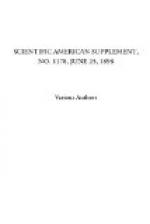To clean wall paper.—Four ounces of pumice stone in fine powder are thoroughly mixed with 1 quart of flour and the mass is kneaded with water enough to form a thick dough. This dough is formed into rolls about 2 inches in diameter and 6 or 8 inches long; each one is sewed up in a piece of cotton cloth and then boiled in water for from 40 to 50 minutes—long enough to render the dough firm. After cooling and allowing the rolls to stand for several hours, the outer portion is peeled off and they are then ready for use, the paper being rubbed with them as in the bread process.—Druggist’s Circular.
Insulating compound.—Prof. Fessenden recommends for armature work a compound made by boiling pure linseed oil at about 200 degrees with 1/2 per cent. of borate of manganese, the boiling being continued for several hours, or until the oil begins to thicken. An advantage of this borated oil is that it always retains a slight stickiness, and so gives a good joint when wrapped around wires, etc. Many substances so used are not sticky and let moisture in through the joints. Where a smooth surface is required, it is readily obtained by dusting on a little talc. It can also be given a coat of japan on the outside.—American Electrician.
How to clean diatoms.—As a general rule, we may say that every specimen of diatomaceous earth or rock needs a special treatment. The following, however, may serve as a basic treatment, from which such departure may be taken in each case as the nature of the specimen would indicate: Boil the material in hydrochloric acid, in a test tube, from two to five minutes. Let settle, pour off the hydrochloric acid, substitute nitric acid in its place, and boil again for two or three minutes. Pour into a beaker of water, stir a moment with a glass rod and let settle. After the material has fallen to the bottom, decant the liquid, and fill with fresh water. Repeat the operation until the water no longer shows an acid reaction. A portion of the deposit may now be examined, and if not clean, boil the deposit with tincture of soap and water in equal parts, decant, wash, first with water, then with stronger ammonia water, and finally, with distilled water. This usually leaves the frustules bright and sharp.—National Druggist.
Red indelible ink.—It is said that by proceeding according to the following formula, an intense purple red color may be produced on fabrics, which is indelible in the customary sense of the word.
No. 1. Sodium carbonate 3 drs. Gum arabic 3 " Water 12 "
No. 2. Platinic chloride 1 dr. Distilled water 2 oz.
No. 3. Stannous chloride 1 dr. Distilled water 4 "
Moisten the place to be written upon with No. 1 and




